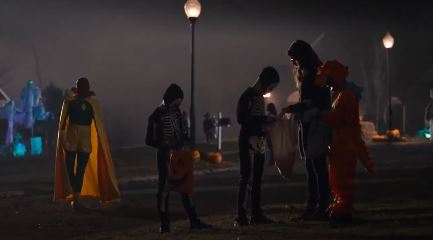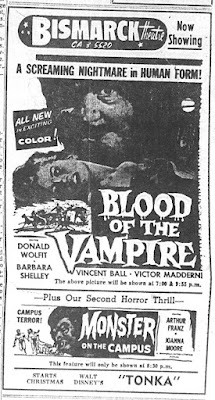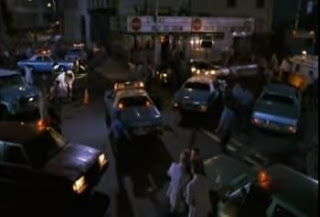Like so many things in my life, this essay started as a joke. When I first watched Jordan Peele’s thought-provoking 2019 horror film Us in the theater, I proposed a double feature with Gordon Douglas’s 1954 giant ant epic Them! Later, on re-watching, I found that, while in many ways as different as different can be, these favorites have some striking commonalities, placing the origin of their horrors in relation to threats internal and external.
Us and Them! both involve people living their normal lives, who encounter incomprehensible and horrific threats which will potentially affect the entire world. Each begins with a little girl, about the same age, who is traumatized to the point of muteness by an uncanny event.


Them! has its climax in the 700 miles of storm sewer tunnels under Los Angeles. Us opens with mention of “thousands of miles of tunnels” under the United States, and the concluding confrontation takes place in one of these tunnels under Santa Cruz, California. In each case, the protagonists must venture into a hidden, interior space, an act with a built-in psychological symbolism.
In Them!, there are authority figures who seem to have things under control, and are the focus of much of the action in fighting the ant invasion. But at the same time, scientists, working for the U.S. military, caused the problem in the first place, so the government is working heroically to solve a problem it created. By contrast, in Us , there are no authorities who can do anything to help. Faced with violent and inexplicable doppelgangers, the family calls 911 early on, and are told the police will be there in 14 minutes, but they never show up. Later, when they find the lines are busy, it’s clearly because there are “too many twins,” and their first call took place at the start of the larger event that will prevent them from getting help.

Among the recurring subjects of horror is the question of whether the threatening elements come from the outside, as an external intrusion, or inside, from the dark side of a person or their community. Many works that are particularly evocative complicate this question. For example in Halloween, Michael Myers seems like an external force of evil that randomly comes upon the teenage babysitters, but he originally sprang firmly from within a nuclear family, killing his sister in their own comfortable home.
One fairly common way of looking at the insides and outsides of horror is through the lens of the “other.” In The Birth of the American Horror Film, Gary D. Rhodes defines this frequently discussed phenomenon as “any race or group of people who were different than healthy white Protestants. With notions of difference came those of white superiority.” Of these others, he says “They are not Us, and so perhaps They should be exhibited for Us to examine” (256, capitalization in the original). All of which raises the question of what’s “other,” in relation to what, and what is just plain old “us.”
In opposition to “us,” the human race, the threat of “Them!” is a distinctly alien part of the natural world, all animal instinct with no human feeling or reason. Us, by contrast, is more psychologically oriented, and the complications of inside and outside form an intrinsic part of its premise.

It’s easy to look at Them! as the epitome of an Atom Age big bug movie, but despite the limited, non-realistic special effects, there is nothing campy or cheesy about it. Much of the film is a straight-forward procedural, first with a local investigation, then the FBI and the Department of Agriculture, all of which creates an environment of plausibility around the events.
When the father-daughter team of scientists arrives, the elder Dr. Medford immediately starts talking about the atomic bomb. He acts as a prophetic voice throughout the film, with many excellent lines: “We may be witnesses to a biblical prophecy come true … the Beasts shall reign over the Earth,” and “we’ve only had a close view of the beginning of what may be the end of us.”
This continues to what becomes a somber ending. With the immediate danger past, there is speculation about all the nuclear explosions that have taken place since the first one, which caused this terrible mutation. Dr. Medford says that “when man entered the atomic age, he opened a door into a new world, and what we’ll eventually find in that new world, nobody can predict.”
The connection to the Atomic Age lies in more than the origin of the monstrous insects: when reporters catch wind that something’s going on, their question is “Has the Cold War gotten hot?”
While killer ants are clearly a “Them!”, a threat that comes solidly from without, they also come symbolically from beneath (in this case, under the desert sand), formed from within the nation by the actions of its highest authorities. The veneer of reassuring resolution ultimately leaves open the possibility of related future nightmares.
In Us, there’s an ambiguity about the identity of the others, who call themselves the Tethered, which has irritated some viewers but plays into the film’s themes. Many reviewers have referred to the sinister doppelgangers as clones, but there’s no real evidence for that, and much of the backstory wouldn’t make sense if they were. The character who explains things, Lupita Nyong’o’s Red, doesn’t really know what’s happening, or exactly how it works, but whatever the mechanics, somehow these shadow selves, dark reflections of living people, were given physical form. An abstraction familiar from Jungian psychology was somehow made corporeal, by what appears to be the government, “so they could use them to control the ones above. Like puppets.”

This is reminiscent of the dead souls being enslaved in Phantasm, or the subplot from Grant Morrison’s Doom Patrol, in which a shadowy government agency captures souls for use by the military, which then have to be controlled and pacified like troubled children.
Arguably, from a psychological perspective, people can and do develop complicated relationships with parts of themselves that they ignore or reject, so the idea that they are “alienated” from themselves doesn’t sound odd to us at all, and this is part of what plays into the film’s themes. Even more, the existence of these others reflects everyone who loses so others can win, representing every form of underclass that suffers away from everyday notice. The conspiracy element illustrates how our unconscious impulses, and the darker sides of our nature, which are here literally unable to express themselves, can be used to manipulate behavior. This can be seen in advertising or political rhetoric that influences people in ways they’re unconscious of, particularly by appealing to their “dark” or shadow sides.

In the film’s prologue, the events are set in motion when a little girl enters a “Vision Quest”-themed Hall of Mirrors, where the sign reads “Find Yourself.” She is inextricably drawn to her shadow self who, we eventually learn, captures her and takes her place in a version of the changeling myth. Here, though, the two remain connected, so that what happens to one affects the other, and the better things are for the above-ground persona, the worse they are for the underground one (part of what makes this some kind of shadow self and not a clone).
But it isn’t that one is the “real” version, and the other a copy or a fake, or that one girl is innocent and the other is a villain. Neither deserves to be imprisoned, especially since they’re legitimately the same person, just somehow manifested into two, with the one kept hidden, unable to communicate, and the other unconscious of the other’s existence. They can be exchanged, and either can fill either role. In this reality, separate as they are, there is no “other.” There’s only us.

Given his obvious interest in exploring American race relations through the context of horror film, it doesn’t seem coincidental that Peele would use tropes of “otherness” in Us. In the study On Monsters: An Unnatural History of Our Worst Fears, author Stephen T. Asma discusses how “the myth of the black monster has had a prosperous career in the twentieth century” (233). He makes a lengthy exploration of the philosophies and psychology behind “the demonizing or monstering of other groups” (234), and ends up quoting a biologist who states that “Us-versus-them thinking comes very naturally to us” (239).
With the likeable Wilsons as our focus for audience identification, the idea of African-Americans as demonized “others” is almost completely brushed aside. The film casually presents the Wilsons as the norm, the average nuclear family, who still identify with touchstones of black culture: in one detail, the nostalgic music from the parents’ youth is a hip-hop classic. But the remembrance of this racial history complicates the fact that the family itself, as successful Americans, is implicated in the suffering of a deeper, invisible underclass. They aren’t “others” because they’re “us,” the same as their richer, crasser white neighbors are, at the same time as those mirror image others exist as a part of themselves.
Yeah, it’s twisty stuff.
It’s too simplistic to treat these films, which were almost randomly selected, as singularly representative of their times. But on some level, they do seem to reflect changes in the way their themes are thought about.
Them! has an archetypally sincere depiction of competent authority, that runs alongside a matter-of-fact view of military complicity in the crisis would be unusual in a contemporary film. By contrast, in something like 2018’s Rampage, the giant monsters are similarly created by science, but it’s motivated by the greed of over-the-top evil villains.
The more cerebral storyline of Us feels very modern. In previous decades, science fiction on the page could be speculative and open-ended, but what appeared on the screen tended to be less ambiguous. The film’s basic situation could have come from an alien invasion film, or the original Twilight Zone, but it’s hard to imagine it becoming so focused on the complications of personal identity and responsibility.

Early on in Us, daughter Zora talks about fluoride in the water, which, in a bit of foreshadowing, “the government uses to control our minds.” When her family responds with silence, she adds, “I forgot. Nobody cares about the end of the world.” At the film’s conclusion, Nygong’o’s character tells her son that “everything’s gonna be like it was before.” This promise is reminiscent of the theoretically conclusive ending of a more traditional kind of horror film, in which the heroes defeat the menace, as happens in Them! Unfortunately, the way it was before was a nightmare for the Tethered, and continuing on the same path would only spawn more monsters, just as continued nuclear testing could theoretically breed more terrifying mutants, however much we want to bury this knowledge in our unconscious minds.








































